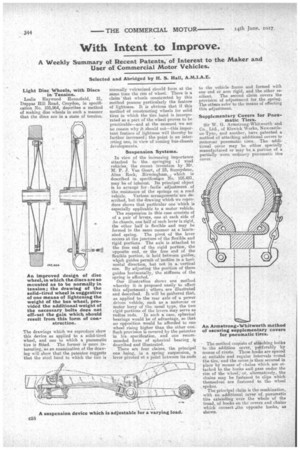With Intent .to Improve.
Page 20

If you've noticed an error in this article please click here to report it so we can fix it.
A Weekly Summary of Recent Patents,' a Interest to the Maker and User of Commercial Motor Vehicles.
Selected and Abridged by H. S. Hall, A.M.I.A.E.
Light Disc Wheels, with Discs in Tension.
Leslie Haywood Hounsfield, 21, Drippas Hill Road, Croydon, in specification No. 105,964, describes a method of making disc wheels in such a manner that the discs are in a state of tension.
The drawings which we reproduce show this device as applied to a solid-tired wheel, and one to which a pneumatic tire is fitted. The former is more interesting, as an examination of the drawing will show that the patentee suggests that the steel band to which the tire is
normally vulcanized should form at the same time the rim of wheel. There is a claim that wheels constructed by this method possess particularly the feature of .lightness. Ills obvious that if this method of constructing wheels for solid tires in which the tire band is incorporated as a part of the wheel proves to be practicable—and at the moment we see no reason why it should not—this important feature of lightness will thereby be further increased; the point is an intereating one, in view of coming bus-chassis developments.
Suspension Systems.
In view of the increasing importance ittached -Eel the springing cf road vehicles. the recent invention by Mr. M. P. J. Van Geert, of 23, Sunnydene, Alun Rock, Birininghano, . which is described in specification No. 105,481, may be of interest. Its principal object is to arrange for facile adjustment of the resistance of the springs on a road vehicle. Various arrangements are described, but the drawing which we reproduce shows that particular one which is especially applicable to a motor vehicle.
The suspension in this case consists of of a pair of levers, one at each side of die chassis, one half of each lever is rigid, the other half is flexible and may be formed in the same manner as a laminated spring. The pivot of the lever occurs at the juncture of the flexible and rigid portions. The axle is attached to the free end of the rigid portion, the opposite end, or the free end of the flexible portion, is held between guides, which guides permit of 'motion in a horizontal direction, but not in a vertical one. By adjusting the position of these guides horizontally, the stiffness of the spring is affected. Our illustration shows one method whereby it is proposed easily to effect this adjustment ; others are illustrated and described. It will be gathered that, as applied to the rear axle of a power driven vehicle, such as a motorcar or motor lorry of the usual type, the two rigid portions of the levers may serve as radius rods. In such a case, spherical bearings would be of advantage, so that no opposition would be afforded to one wheel rising higher than the other one.. Such provision is covered by the patentee in his specification, and one recommended form of spherical bearing is, described and illustrated.
There are four claims, the principal one being, in a spring suspension, a lever pivoted at a point between its ends
to the vehicle • frame and formed with oneend or arm rigid, and the other resilient.The second claim covers the provision of adjustment for the spring. The others refer to the means of effecting this adjustment.
Supplementary -Covers for Fazio-. matic Tires.
Sir W. G. Armstrong-Whitworth and Co., Ltd., of Elswick Works, Newcastleon-Tyne, and another, have patented a method of attaching aelditional covers to motorcar pneumatic tires. The additional cover may be either specially manufactured or may be, a portion of a partially' worn ordinary pneumatic tire cover.
• The method consists of attaching hooks to the addition cover, preferably by means of rivets. These hooks are spaced at suitable and regular intervals round the tire, and the cover is then secured in place by means of chains which are attached to the hooks and pass under the rim of the wheel; or, alternatively, the chains may be fastened to clips which themselves are fastened to the wheel spokes. The principal claim is the combination, with an additional cover of, pneumatic tire extending over the whole of the tread, of hooks on the covers and chains which connect „the opposite hooks, as shown.




















